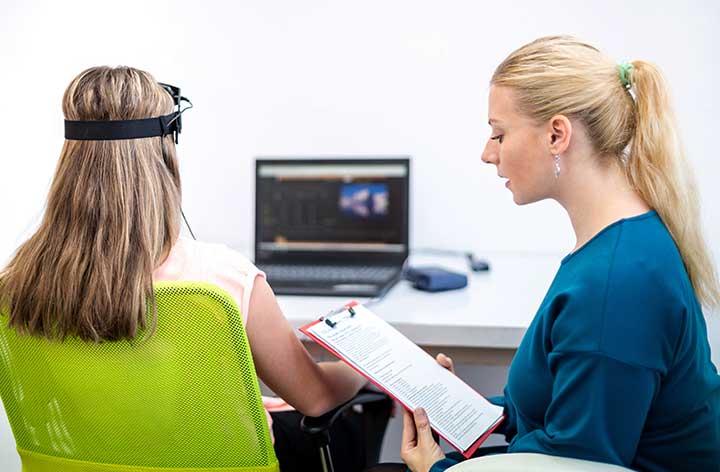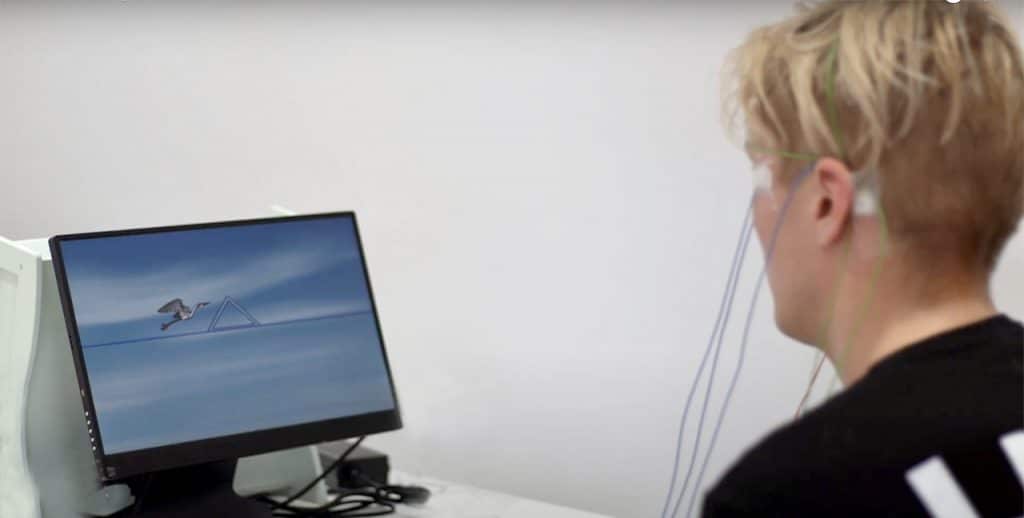Neurofeedback in the treatment of psychosomatic illnesses
What is Neurofeedback?
Neurofeedback, also known as EEG biofeedback or neurotherapy, is a non-invasive therapy method that uses real-time monitoring of brain activity to self-regulate brain function.
In neurofeedback training, brain activity is monitored and real-time feedback is given to the patient. This feedback helps the patient to regulate and train their own brain waves, which can improve symptoms and overall well-being.
This innovative method has gained popularity in recent years, particularly in the field of mental health, where it has been shown to be effective in treating a variety of psychosomatic conditions, including depression, anxiety, ADHD and PTSD. Psychosomatic illnesses are conditions that manifest through physical symptoms but have an underlying psychological cause. This article explains the principles of neurofeedback and its application in the management of psychosomatic disorders. At our clinic in Mallorca, we have been successfully using neurofeedback to support ketamine therapy and psychotherapy for years. We now also offer portable Neurofeedback devices that can be used easily in the comfort of your own home.
MORE INFORMATION ABOUT OUR PORTABLE NEUROFEEDBACK SOLUTIONS>>>
Neurofeedback is an evidence-based treatment method that originated in the USA in the early 1970s. There are now comprehensive scientific studies on the effectiveness of this method.
Portable Neurofeedback
How does neurofeedback training work?
Neurofeedback training is based on the principle that the brain can function more efficiently by providing feedback on its activity. Neurofeedback works by measuring brain activity using electroencephalography (EEG) or near-infrared spectroscopy (NIRS). Electroencephalography (EEG) is the main tool used in neurofeedback and measures the electrical activity of the brain, while NIRS measures changes in blood oxygen levels in the brain. During a neurofeedback session, sensors are placed on the scalp to measure the electrical activity in the brain. The data is then processed and presented to the person in real time as visual or auditory feedback.

For example, a user might see a ball moving across a screen. The speed of the ball is determined by the user’s brain activity. If the user’s brainwaves are in a desirable range, the ball will move quickly. If the user’s brain waves are in an undesirable range, the ball moves slowly. The user can then learn to control their brainwaves to keep the ball moving.
Make an appointment now for a psychotherapeutic evaluation session
What are the benefits of neurofeedback?
Neurofeedback has been shown to be effective in treating a variety of mental health conditions. The potential benefits of neurofeedback include:
- Reduced symptoms of depression, anxiety, ADHD and PTSD
- Improved cognitive function
- Increased self-confidence
- Reduced stress
- Improved sleep quality
We use neurofeedback in Mallorca for various psychosomatic conditions. Complaints such as sleep disorders can be successfully treated within 10 to 15 sessions. For other disorders or clinical pictures such as migraines or depression, more sessions are usually necessary, depending on the severity of the illness. The method is non-invasive. It can reduce or completely eliminate the need for medication.
Use of neurofeedback for psychosomatic illnesses:
Stress and anxiety:
Neurofeedback has been shown to be effective in treating stress and anxiety-related psychosomatic symptoms. By addressing specific brain wave patterns associated with relaxation and calmness, people can learn to self-regulate their stress response and thus reduce the physical symptoms of chronic stress.
Migraines and headaches:
Psychosomatic headaches and migraines can often be triggered or exacerbated by psychological factors. Neurofeedback helps individuals recognize and regulate the brainwave patterns associated with these symptoms, which can lead to a reduction in the frequency and intensity of headaches.
Chronic pain:
Neurofeedback has been studied as an adjunctive therapy for people with chronic pain with a psychosomatic background. By influencing the neural pathways related to pain perception, neurofeedback can contribute to pain management strategies.
Gastrointestinal disorders:
Some gastrointestinal disorders, such as irritable bowel syndrome (IBS), can be influenced by stress and emotional factors. Neurofeedback aims to regulate the brain activity associated with these emotions and can thus help to alleviate psychosomatic symptoms associated with gastrointestinal complaints.
Sleep disorders:
Psychosomatic sleep disorders, such as insomnia, can benefit from neurofeedback interventions. By addressing the brain wave patterns associated with sleep regulation, people can experience improvements in the quality and duration of their sleep.
Neurofeedback as an alternative treatment method
- Neurofeedback can be an alternative treatment when medication cannot be used
- Neurofeedback can be an alternative when medication has not been effective
- The treatment can be used as an alternative to medication during pregnancy
- Neurofeedback therapy has no side effects and is generally suitable for children from the age of 4 and adults with disabilities

Neurofeedback in the treatment of depression:
Depression, a common psychosomatic disorder characterized by persistent feelings of sadness and loss of interest, is the focus of exploration in the use of neurofeedback. Research suggests that people with depression often exhibit specific patterns of brain activity, and neurofeedback aims to address and change these patterns. By targeting brain regions associated with the regulation of mood, such as the prefrontal cortex, and adjusting the balance of alpha and beta brain waves, neurofeedback can help alleviate depressive symptoms. This approach allows people to gain greater control over their emotional states by learning to modulate the neural activity associated with mood regulation. Although neurofeedback is not a sole solution for depression, it has shown promise as a complementary therapy that can potentially improve the effectiveness of conventional treatments such as psychotherapy and medication. At our clinic, we always use neurofeedback in addition to other therapies such as ketamine infusions and rTMS, achieving faster and longer-lasting results than either therapy alone.
As research in this area progresses, neurofeedback could play an integral role in comprehensive approaches to the complex challenges of depression and other psychosomatic disorders.
What are the benefits of neurofeedback training for depression?
Neurofeedback training has been shown to be effective in reducing the symptoms of depression. Neurofeedback can help to:
- Reduce feelings of sadness and hopelessness
- Improve the quality of sleep
- Increase energy levels
Improve concentration - Boost your mood
Neurofeedback is also a safe and non-invasive treatment method. There are no known side effects of neurofeedback and it can be used in combination with other treatments for depression such as psychotherapy, ketamine therapy and rTMS.
Neurofeedback in combination with ketamine infusions:
In recent years, the combined use of neurofeedback and ketamine infusions has been explored in the treatment of psychosomatic disorders, including depression. Ketamine, a dissociative anesthetic, has gained notoriety for its rapid antidepressant effects by modulating glutamate neurotransmission and promoting synaptic plasticity (the brain’s ability to change and form new connections).
When combined with neurofeedback, which focuses on the regulation of specific brainwave patterns, a comprehensive and complementary approach is created. The neurofeedback sessions provide patients with tools to improve self-regulation and emotional resilience, while ketamine infusions can create a neuroplastic environment conducive to long-lasting positive changes in mood. This dual approach aims not only to relieve acute symptoms, but also to treat underlying neuronal dysregulations that contribute to psychosomatic illness.
Neurofeedback can help stabilize brain activity and promote neuroplasticity, while ketamine can provide rapid and sustained improvement in mood symptoms.
Research on this combined therapy model is still ongoing, but many studies show this method to be a promising option for people suffering from treatment-resistant depression or looking for more holistic and individualized interventions.
A study published in the journal Clinical Psychopharmacology and Neuroscience found that patients with depression who received both neurofeedback and ketamine infusions had a significantly greater improvement in their symptoms than patients who received only one of the two treatments.
Another study published in the journal “Frontiers in Psychiatry” showed that neurofeedback and ketamine infusions were effective in treating patients with treatment-resistant depression. Treatment-resistant depression is a type of depression that does not respond to standard treatments such as medication and psychotherapy.
With the integration of neurofeedback and ketamine infusions, this approach is gaining momentum and offers mental health professionals the ability to customize treatments to each individual’s unique needs.
Although the combination of neurofeedback and ketamine infusions is a promising approach to treating depression, there are several clinical considerations that should be taken into account when providing treatment.
- Neurofeedback and ketamine infusions should be administered by a qualified healthcare professional.
- Neurofeedback and ketamine infusions should be tailored to the patient’s individual needs and response to treatment.
- Patients should be closely monitored for possible side effects of treatment (mostly mild and transient symptoms such as dizziness, headache, fatigue, anxiety).
Use of neurofeedback at home:
Advances in technology have enabled the development of neurofeedback systems that can be used in the home. We now work with the Divergence Neurofeedback System, which makes it possible to perform neurofeedback at home more conveniently and frequently. The Divergence Neurofeedback System for home use consists of a headset with EEG sensors and software (app) that guides users through neurofeedback exercises.
Our programs have the ability to adapt to training protocols in real time based on analysis of individual brainwave patterns to optimize the neurofeedback experience. The Divergence Neurofeedback System aims to increase the efficiency and effectiveness of neurofeedback by customizing interventions to each user’s unique neurobiological profile. This personalization promises to enable more precise and targeted interventions in the treatment of psychosomatic disorders
While initial professional guidance is recommended to ensure proper setup and understanding, over time patients can learn to perform neurofeedback sessions on their own. This democratization of neurofeedback gives users the opportunity to actively participate in their mental health and well-being. However, it is important to emphasize that neurofeedback at home should be approached with caution, as professional supervision is important for accurate interpretation of EEG data and for tailoring training to individual needs. Nevertheless, integrating home neurofeedback into treatment plans can improve continuity of care and provide patients with a more flexible and personalized approach to promoting mental and emotional balance.
As technology continues to evolve, systems such as the Divergence Neurofeedback System present the potential for even more sophisticated and individualized approaches to neurofeedback and offer interesting approaches for improved interplay between neuroscience and therapeutic interventions.
More about our portable Neurofeedback devices
Neurofeedback is a promising new treatment option for mental health. It is a safe, non-invasive and effective treatment that can help people improve their symptoms and overall well-being.
The combination of neurofeedback and ketamine infusions represents a new and potentially transformative approach to treating depression. Research shows that this combination is more effective than either treatment alone, especially for patients with treatment-resistant depression. While research continues to advance, this treatment approach is already a valuable addition to our therapeutic work for depression.
If you are considering neurofeedback treatment, talk to your doctor to see if it is right for you.
F.A.Q. Neurofeedback
Frequently asked questions about treatment with neurofeedback
Treatment is usually covered for privately insured patients, depending on the contract. For patients with statutory health insurance, it is often a case-by-case decision. If several unsuccessful attempts have already been made to treat depression, this is referred to as treatment-resistant depression. In this case, the chances of costs being covered or at least a contribution to the costs are good.
We are currently the only center in Europe that offers ketamine therapy, rTMS, neurostimulation and intensive psychotherapy at the same time.
Neurofeedback is a sustainably effective method for treating disorders of self-regulation and impulse control. The aim of the therapy is to improve the quality of life in various neuropsychiatric disorders over the course of several sessions. During a session, a client’s brain activity (EEG) is measured and converted into images using a computer. This visual feedback allows unconscious neurophysiological processes to be made perceptible. During the feedback, the client is given tasks to solve. These are set in such a way that the brain must achieve a certain level of activity in order to receive positive feedback. This change occurs when concentration increases or perception improves. The principle of operant conditioning is used to ensure that the brain increasingly shows beneficial activities. Under the guidance of a therapist, clients can learn to perceive these neurophysiological processes. Dysregulation can thus be recognized and effective countermeasures implemented.
The effectiveness and sustainability of neurofeedback therapy has been investigated and proven in scientific studies. It has been proven that the ability to control and regulate one’s own bodily processes can be learned. Medication that merely combats symptoms can often be reduced with bio/neurofeedback therapy. Neurofeedback does not work on symptoms, it tackles the causes. The S3 guideline on ADD/ADHD also makes clear recommendations for neurofeedback treatments. This is because neurofeedback can only be optimally effective and sustainable if it is used correctly.
Neurofeedback training should take place in a room with a feel-good atmosphere. The client sits relaxed on a comfortable chair or armchair. The application of the electrodes can be combined with a short introductory talk. During the session, the therapist should observe the client and the progress of the curves in order to provide assistance if necessary. If necessary, the training can be paused. After the neurofeedback training, the session should be evaluated together and transfer exercises carried out. The transfer includes methods that help to transfer what has been learned into everyday life.
- headaches
- dizziness
- fatigue
- anxiety
Neurofeedback works for everyone. We achieve particularly good results with people who:
- Have a mental illness that has not responded to other treatments
- Are looking for a non-invasive and drug-free treatment option
- Are willing to pursue regular therapy, either in our clinic or with our portable neurofeedback options for home use.
The number of neurofeedback sessions you need depends on the severity of your symptoms and your response to treatment. Most people see an improvement after 10-20 sessions.







